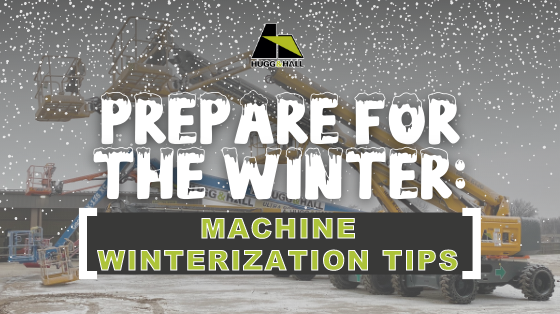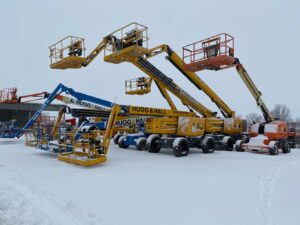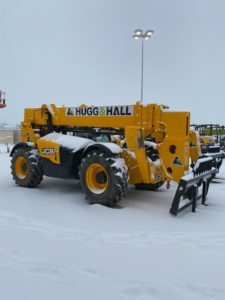
Prepare for the Winter: Machine Winterization Tips
Winter brings shorter days, frigid temps, and icy conditions. During this time of year, we need to take extra care of our equipment to avoid any damage. Read on to learn some tips on machine winterization!
Want more information? Download our complete guide to winter construction site prep!
MACHINE WINTERIZATION TIPS
Follow these best practices to make sure your equipment is ready for winter.
Check the fuel filter. A clogged fuel filter can build up moisture and freeze. Empty the water traps in the filters before cold weather arrives. To avoid downtime, keep an extra set of fuel filters in your cab.
Check for water in chain tanks, final drives, swing gear baths, and gear boxes.
Use coolant that complies with ASTM standard D-621, with a freeze point low enough for your climate. If coolant freezes, it can crack the engine block and ruin the engine.
Add fuel conditioner. Fuel conditioner prevents your fuel from freezing. The amount of fuel conditioner you will need varies depending on the brand and model of the machine, so check the manufacturer’s recommendation. Always match the fuel conditioner to the type of fuel you’re using (e.g. low sulfur).

Check diesel cold start aids. Diesel engines spray ether into the air system to help the engine start in cold weather. For older machines that have ether spray bottles, check the bottle to make sure it isn’t empty. For newer machines with an automatic ether system, inspect the connections and hoses for cracks or loose connections.
Check the block heater. Block heaters keep fluids at the optimum temperature and viscosity. If the block heater isn’t working, the oil can thicken, making it harder to turn the engine over and causing added stress on the battery. To test that it is working properly, plug in the heater and ensure the hoses are warm.
Inspect air intake pre-cleaners. Snow and ice can collect around dust particles and debris in the pre-cleaner, which allows moisture into the air system. It can cause engine failure. Remove any debris from the pre-cleaner before winter.
Check battery and connections. Battery connection corrosion increases strain on the battery and can drain it. Periodic inspections for corrosion can reduce the chance of having a dead battery.
If your machine is still giving you trouble after you perform these winterization tips, contact our service department!
WINTER STORAGE
Run the engine after cleaning. Run your machine after cleaning the engine and replacing the oil. Running the machine coats the internal parts in a protective film of oil and prevents rust. Pour a 50/50 mixture of water and antifreeze into the coolant system before running to protect the cooling system up to -34°F.

Clean and fully charge batteries, then disconnect the power leads. Never store discharged batteries. Colder temperatures slow the discharge rate of fully charged batteries.
Start machines once a month. If the weather is slightly warmer, take the opportunity to start your machine. Avoid starting machines in extremely cold weather. Find a time when the temperature is above freezing to start the machine and fully warm hydraulics after the engine comes to operating temperatures.
Drain the fuel tank, if possible. If you have a diesel engine, either drain the engine or leave it completely full during the winter months. Draining the fuel tank can be time consuming, but this eliminates the possibility of condensation forming in the fuel tank and spreading. Condensation can clog the fuel filter, fuel lines, carburetors, and injectors.
Never try to break crawler-type machines from a badly frozen situation. It can result in powertrain damage.
COLD WEATHER OPERATION
Protect your machinery. If you can’t keep your machine inside when it is not in use, keep a water-resistant tarp over the engine. Condensation and moisture can cause problems for the entire engine.
Manage productivity. Most projects take longer during winter. Cold weather makes the earth harder. Frost can penetrate roadways and make utility, road, and crushing jobs much more difficult and time-consuming. Time management is important.
Be prepared to add additional power, heat, and lighting. Generators and heaters can keep your space warm and well-lit. Lights are a great option if you need to work before sunrise or after sunset.
Clean areas designated for snow removal. Clean up debris or equipment that will be hidden by fallen snow. Mark any areas of concern with reflective stakes, so snow removal crews can easily identify and stay away from those areas.
Warm up machines to improve steering response. Let machines come up to operating temperature before working. Steering response on equipment with hydraulic steering may become very slow at low temperatures, even when the correct oils are used.
Check for ice buildup. Check for ice or snow buildup in exhaust or intake if applicable. Inspect and clear any ice or snow from the throttle and brake area.
Use standard safety practices. Use the three points of contact when stepping into a machine. Snow, ice slips and falls are a common cause of injuries. Wear your seatbelt when operating equipment and stay alert.
Take care of groundwork before it freezes. Plan to complete any groundwork before the weather gets bad. You should also be prepared for muddy conditions in any areas where groundwork has not been completed.
Prepare your equipment, jobsites, and employees for these temperatures to help avoid injuries and downtime from work. Visit our blog to learn more winter safety tips!
Editor’s Note: This post was originally published in January 2022. It was updated for freshness, accuracy, and comprehensiveness in January 2024.
Back to News
Subscribe and unlock cutting-edge equipment insights, trends and tips!
Subscribe